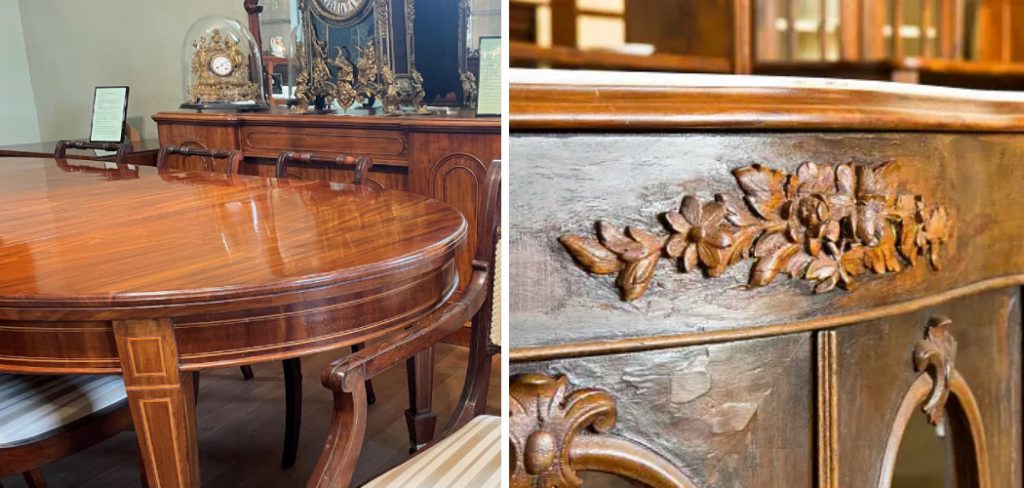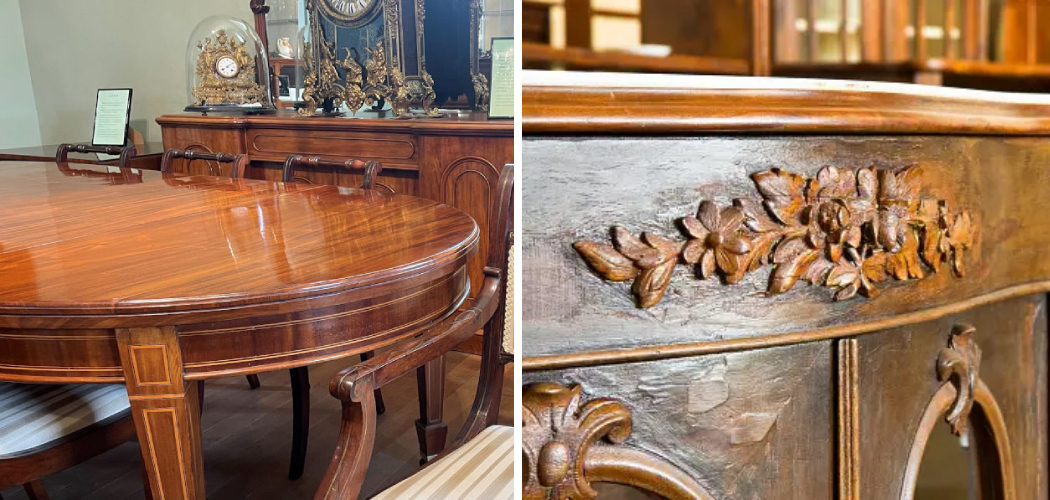Are you an avid antique enthusiast or just a curious shopper looking to find out if that piece of furniture is really as old as it claims? Figuring out how to identify antique wood furniture can sometimes be difficult, but with the right knowledge and some basic steps, it’s not too hard.

In this blog post, we’ll take a look at the simple techniques used by experts in order to help you ascertain whether your potential purchase is truly the real deal.
What is Antique Wood Furniture?
Antique wood furniture is defined as any piece of furniture that is at least 100 years old. This means the item was likely made before 1920, and could even date back to the mid-1800s.
That said, antique wooden furniture can be somewhat hard to identify since it doesn’t always have obvious signs of wear or age. That’s why you have to look a little deeper in order to make sure your potential purchase is authentic.
How to Identify Antique Wood Furniture?
There are several methods used by experts when attempting to determine an item’s authenticity:
1. Construction:
Take a close look at the overall construction of the piece. Look for joints that are hand-cut using a saw, as opposed to machine-cut joints which became commonplace after the industrial revolution.
2. Wood Type:
Identifying the type of wood used can also help you determine the age of a piece. Mahogany and walnut were commonly used for furniture during this era, but if your potential piece contains cherry or oak it could be even older.

3. Hardware:
Examine any hardware such as latches, hinges or knobs to see if they’re original or not. If they have been replaced with modern items then it’s likely that the piece is not authentic.
4. Patina:
Patina refers to dullness in the wood caused by years of use and exposure to sunlight. This is a good sign that your piece could be an antique, but beware as patina can also be faked.
5. Stamps & Labels:
Look for any stamps or labels on the inside of drawers or underneath the furniture itself. Often times these will denote when and where it was made, which can help you confirm its authenticity.
11 Step-by-step Guides on How to Identify Antique Wood Furniture
Step 1: Carefully Examine the Construction
Look for joints that appear to be hand-cut instead of machine-cut. This is a sure sign that the piece is an antique. It could also contain nails or screws which were commonly used during this period.
It’s also important to note that machine-cut joints weren’t widely available until the industrial revolution. But beware, as some unscrupulous dealers may use old nails and screws to make it appear older than it is.
Step 2: Inspect the Wood Type
If the piece is made of Mahogany, Walnut, Cherry, or Oak then it could be an antique. These types of woods were all popular during this era and can help you identify authenticity.

It’s also important to note that over time, certain types of woods were favored more than others. Knowing this information can help you determine the age of the piece. This is why it’s important to be familiar with the history of wood furniture in order to verify its authenticity.
Step 3: Check for Original Hardware
Take a close look at any hardware such as latches, hinges or knobs to make sure they’re original and not modern reproductions. This can help you ascertain whether the piece is authentic or not.
It’s also important to note that many antique pieces may have had their hardware replaced over the years, so it’s not a sure sign of inauthenticity. It’s best to look for other signs of age on the piece if you suspect it may be a reproduction.
Step 4: Look for Patina
Patina is a dullness in the wood caused by years of use and exposure to sunlight. Authentic antiques will likely have this patina present, although it can sometimes be faked. But beware, even if the patina appears to look genuine it doesn’t necessarily mean that the piece is an authentic antique.
This is why it’s important to look for other signs of age on the piece as well. If the patina is combined with other signs of age then it’s more likely that the piece is an antique.
Step 5: Look for Stamps and Labels
If you can find any stamps or labels on the inside of drawers or underneath the furniture itself then this is a good sign that the piece is an antique. It may even give you clues as to when and where it was made which can help you confirm authenticity. But beware, some unscrupulous dealers may forge these stamps and labels in order to make it appear older than it is.

Step 6: Measure Dimensions
Take measurements of your piece from multiple angles in order to compare it with other pieces from similar eras. This is a great way to tell if something has been altered or not.
This is especially helpful if you’re comparing it to furniture from the same time period. If the dimensions are off then it’s likely that the piece has been altered or repaired. It’s important to note that some alterations are acceptable and may even add to the value of a piece.
Step 7: Compare with Catalogs & Exhibits
Compare your potential purchase with similar pieces that have been cataloged or exhibited in museums. You can also search online to find images of antique pieces for comparison.
If the piece you’re looking at matches up with any of these then it’s likely an authentic antique. This is a great way to confirm a piece’s authenticity without having to go through the process of appraising it. It’s also a good way to find out more about the piece’s history and provenance.
Step 8: Research the Maker
Try researching the maker of the item, as this can help you determine if it is an antique. Knowing who made a piece and when they were active can give you more clues about its age and authenticity. It’s also important to note that some makers had a specific style of making furniture that can be identified with just a quick look.
Step 9: Look for Signs of Restoration
Look for any signs that your potential purchase has been restored or repaired in any way. This could include new wood patches, nails, screws, or other hardware added to replace missing parts. This can be a good indicator that the piece is an antique, as it means someone has taken the time and effort to keep it in its original condition.
Step 10: Examine Details & Joinery Carefully
Take a close look at details such as dovetail joinery, which can help you determine if the piece is hand-made or machine-made. If it is hand-made then it may be an antique, although this isn’t always the case. It’s also important to note that some furniture makers used a mix of machine and hand-made joinery, so you should look for other signs of age on the piece as well.
Step 11: Get a Professional Opinion
If you’re still unsure about your potential purchase, then it could be time to seek out an expert opinion. Antique appraisers and dealers will be able to tell you definitively whether the item is authentic or not. But beware, these services can be costly so make sure you do your own research before seeking out an expert.

By following these simple steps, you should now have a better understanding of how to identify antique wood furniture. Remember that it can take some time and research in order to ensure authenticity, so don’t rush into any purchase! With a little knowledge and effort, you can confidently shop for antiques knowing that your purchase is truly what it claims to be.
Frequently Asked Questions
Q: What is Antique Wood Furniture?
A: Antique wood furniture is defined as any piece of furniture that is at least 100 years old. This means the item was likely made before 1920, or even earlier.
Q: How Can I Tell if a Piece of Wood Furniture is Antique?
A: There are several methods used by experts when attempting to determine an item’s authenticity such as looking for hand-cut joints, inspecting the type of wood used, checking for original hardware, examining patina and looking for stamps or labels.
Q: Is It Worth Buying an Antique Wooden Furniture?
A: Depending on their condition and rarity, antiques can be an excellent investment. However, it’s important to know what you’re buying first. Be sure to take your time researching and authenticating any potential purchase before committing to a purchase.
Q: What is the Difference Between Antique and Vintage Wood Furniture?
A: Generally, vintage wood furniture is defined as any piece that is at least 20 years old but not more than 100 years old. Any item over 100 years old would be considered antique. However, this definition can vary depending on the context in which it’s used.
Conclusion
After reading this article, you now know how to identify antique wood furniture. Whether you are attempting to restore a piece for a family heirloom or simply wish to know the origin of an item, these steps can help you determine if it is an antique or not.
As always when working with furniture, be aware that some wooden pieces are quite fragile and must be handled carefully. With time and patience, though, you can ready your antique wood furniture for use in any space. Now that you know more about antique wood furniture, why not continue giving your living space a makeover?
Make sure to check out our next blog post detailing how to organize deep bathroom drawers and maximize storage space. This will allow you to keep your bathroom neat while also finding a place for all of your items. Thanks again for reading and go ahead now and take on organizing that deep bathroom drawer!

